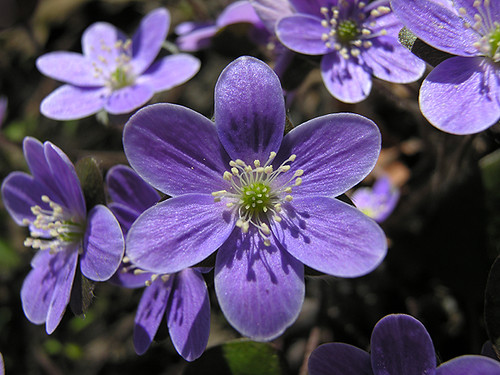Hepatica triloba Ranunculaceae
Hepaticas are woodland plants with no special requirements as to moisture or care. They frequently spread to form natural plant communities as in their natural habitat.
They do well in rich sandy humus rich soil with an admixture of limestone rubble. They like to remain undisturbed and if not transplanted unnecessarily they spread well and bear a profusion of flowers in February to April.
Particularly attractive are the double garden varieties H. triloba 'Alba' with white blossoms, `Rosea' with pink blossoms and aubra' with red blossoms and flowers in March or April.
H. angulosa a slightly larger plant with five-lobed leaves, bears pale blue or pinkish flowers but flowers somewhat earlier in February and March. It is especially suitable for the wild garden as it spreads freely.
The Twin Leaf ( jeffersonia), Hacquetia, Sweet Violet (Viola odorata), dwarf ferns, ornamental grasses and Anemones are often planted near them. The green leathery leaves appear after flowering and remain throughout the winter.
Propagation is by seed, sown as soon as ripe, or division of clumps in the autumn. The double forms, which can be propagated only by division after flowering, multiply fairly slowly.
St. John's Wort Hypericaceae
Hypericum rhodopaeum
St. John's Worts are rewarding rock plants and great favorites for their long flowering period and wealth of blossoms. They are good in rock gardens and dry walls, in beds amidst low-growing perennials and on slopes. All have yellow flowers with striking finely radiating stamens.
Hypericums are either herbaceous or semi-shrubs which prefer loose, light, slightly humus rich soil but grow in any good garden soil, and require warm sunny positions. Excess tinoisture, especially in winter, is detrimental therefore the drainage should be good. In suitable situations they live long and attain a great height.
Of those suitable for the rock garden and dry wall several low-growing species are fairly common in cultivation, e.g. H. rhodopaeum, which makes low, thick shrub lets with blue- green foliage and bright yellow flowers borne in profusion every year as early as May.
H. cons, a lime lover, has narrow leaves; smaller golden yellow flowers and attains a height of only 4 to 6 inches (10 to 15 cm.). In winter it should be protected in wet weather.
H. olympicum is a popular and commonly cultivated Hypericum, 8 to 12 inches (20 to 30 cm.) high, also distinguished by a great wealth of large, orange-yellow blossoms appearing in June and July and later, sometimes until September.
St. John's Worts should be cut back after flowering and top dressed with old, well rotted compost every couple of years. In winter they require a light protective covering of fir branches or bracken.
You can visit this flower guide for more information about this article.


No comments:
Post a Comment